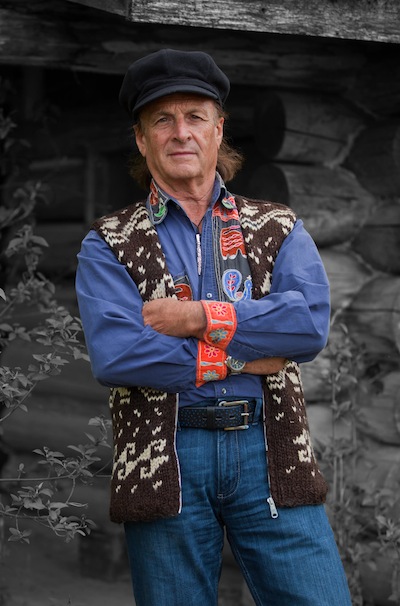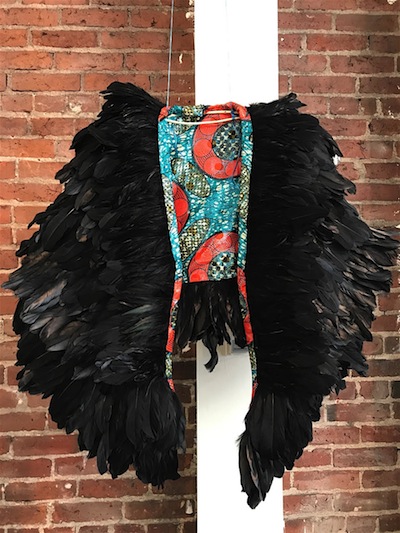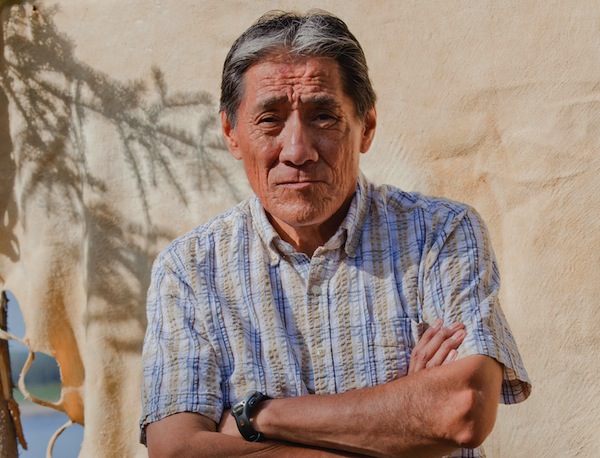Linda MacCannell’s photograph of John T’Seleie. (photo from Drew Ann Wake)
The new show at the Zack Gallery, Crossed Paths – which explores the connection between the Jewish and the Dene peoples – has its roots in the federal Mackenzie Valley Pipeline Inquiry.
“In the 1970s, I was a CBC reporter in the Northwest Territories,” show curator Drew Ann Wake told the Independent. “When the government proposed a pipeline through the area, they sent Justice Thomas Berger to investigate the impact of the proposed pipeline [in 1974]. He talked to over 30 native communities to get their input. When he was finished, he issued a report recommending the government settle all the claims on land that the pipeline would pass through before construction started…. They are still settling those claims. The pipeline hasn’t been built yet.”
As a journalist, Wake accompanied Berger and his team on that historic trip. She taped numerous interviews with the local people participating in the inquiry.
“Ten years ago, I found those old tapes,” she recalled. “Only audio tapes; it was so long ago. I thought it would be interesting to go back and talk to all of them again. And let their children and grandchildren listen to their elders’ voices.”

She invited a friend, photographer Linda MacCannell, to create portraits of some of the participants of the Mackenzie Valley negotiations. Over several years, they traveled to the villages Wake had visited with Berger. MacCannell took photos and Wake filmed her interviews. “We created a show of Linda’s portraits and the stories I collected and went on the road. By now, we’ve exhibited this show in 50 galleries across North America,” said Wake.
MacCannell’s large-scale portraits of various members of the Dene First Nations, who live along the Mackenzie River, constitute the heart of the exhibit at the Zack.
“Two years ago, we gave a presentation at the grunt gallery, an artist-run centre in Vancouver,” Wake explained. “We showed the films. After the presentation, a man approached me. He introduced himself as Michael Shumiatcher, a local artist and educator. He said he knew Justice Berger at the time of the inquiry. Michael was a high school student then, and Berger was his best friend’s father.”
Shumiatcher suggested they work together and present the exhibit to schools around the province. Wake liked the idea, and invited him to join her on her next trip north. Also joining the summer 2018 trip were artist Melenie Fleischer and her husband, cellist Eric Wilson, as well as composer Daniel Séguin.
“Daniel saw the video I made of the drummers the previous year,” Wake explained. “He wanted to write new music to incorporate the traditional drums.”
The group traveled to Fort Simpson, N.W.T., to study the drumming culture of the Dene in more depth.
“Séguin wrote a piece of music, called Dehcho, for cello and the drums,” Wake said. “That is how the local nations call the Mackenzie River – Dehcho. Wilson performed it at the local gallery presentation of our show. The gallery was packed. People sat in the hall and stood on the stairs. He had to repeat his performance for all who wanted to hear it.”
As well, Fleischer and Shumiatcher produced several paintings.
One of Fleischer’s, a herd of bison, is suffused with wild, tumultuous energy. “They were huge,” she said of the animals. “They looked up casually and continued grazing and drinking water in the shallow puddles. We were cautious and maybe even scared as we huddled close in the van to take our photographs. Thrilled at our first encounter with the ancestors of the ancient bison depicted on the cave walls of Altamira, Lascaux and others, I knew then that I was going to paint bison.”
A painting by Shumiatcher depicts Wilson blowing a shofar on the shore of the Mackenzie River. Fleischer and Wilson brought the shofar on the trip as a gift.
“Once we got our invitation from Chief Gerry Antoine to come to Fort Simpson and collaborate with Liidlii Kue First Nation on our cultural exploration of music – cello and drums – we were very excited. We were in New York at the time, and I wanted to bring Chief Antoine something special,” said Fleischer. “All I could think of was that our nation was thousands of years old, as were the indigenous people. With that in mind, we went looking for a ram’s horn from Israel, a shofar.”
They visited several Judaica stores in New York. “It was funny,” said Fleischer, “my husband Eric blowing shofars outside the stores, on the sidewalk. He is a cellist and very particular about sound.”
The next step for the group was to approach the Zack Gallery for a joint show. The Jewish artists’ paintings complement MacCannell’s photography, showing another facet of the northern experience. Just as power and serenity dominate the portraits and the photographer’s triptych of the river landscape, the paintings add a touch of awe at nature and its symbiotic relationship with humankind.
The Zack exhibit also includes traditional clothing made by several Dene artists. “Last year, we won a grant from the Canada Council [for the Arts] to commission northern artists,” Wake said. Of the pieces on display, each has a story. In some cases, the stories are real; they happened to the artists’ family members. For others, the stories are purely imaginary or are based on local folklore. Regardless, every story has a link to the tapes Wake collected in the 1970s and the people she interviewed.
Linda Wolki, known for her needlework, created a traditional yellow coat after she listened to the recording of her mother telling Wake how she hunted seals when she was young. “The woman’s story was amazing,” Wake said. “She was out hunting in the snow and cold, and four polar bears decided to chase her. She laughed.”
A pair of embroidered moccasins, made by Agnes Mitchell, is displayed in a plexiglass case next to the pair her father wore for years. The embroidery on the old moccasins – made by Mitchell’s mother – and the new ones is equally elaborate.
“One story I asked an artist to illustrate was an ancient northern legend about an abandoned woman,” Wake said. “The tribe abandoned that woman in the forest because of her sharp tongue. She only had a few coals for her fire, but she survived. She made herself two cloaks – one of raven feathers and another of rabbit fur – and many more objects.”
Artist Jeneen Frei Njootli has brought the cloaks to life. Her creations, a black cloak of raven feathers and another of white rabbit fur, hang in a corner of the Zack, one above another, as a tribute to her people’s tenacity and their drive to survive in the harshest conditions.

“We were very proud to learn that recently Jeneen Frei Njootli was chosen as one of the five finalists for the Sobey Art Award, an annual prize given to the most promising Canadian artist under 40,” said Wake, who then pointed to a blue coat on display. Smiling, she said, “And that coat belongs to Michael Jackson. But not the Michael Jackson of pop music. Our own Michael Jackson, a Vancouver lawyer who, in the 1970s, was part of Justice Berger’s team.”
When Wake started working on this show, one of the new interviews she conducted was with Jackson. “He worked with many First Nation people,” she said, “and I asked him how come he was so empathetic to their plight. He said it was because he was Jewish. When he grew up in London, England, he experienced antisemitism. He knew hunger as a child in post-World War Two Britain. It made him sensitive to others suffering from discrimination. Made him want to help.”
During the Berger inquiry, Jackson befriended one of the local men, John T’Seleie, who organized his community to meet with the inquiry’s lawyers.
“Their friendship has lasted for decades. They’re still friends,” Wake said. “As a child, T’Seleie was a student at a residential school. Like many others at residential schools, he suffered. As an adult, he became an advocate for his people.”
The portraits of these two friends hang side by side on the gallery walls, and the film Wake made of her interviews with them is also part of the exhibit.
“That’s how our entire show started, so many years ago,” she said, “with those two and their friendship: a Jew and a Dene.”
Crossed Paths is at the Zack until April 7.
Olga Livshin is a Vancouver freelance writer. She can be reached at olgagodim@gmail.com.

